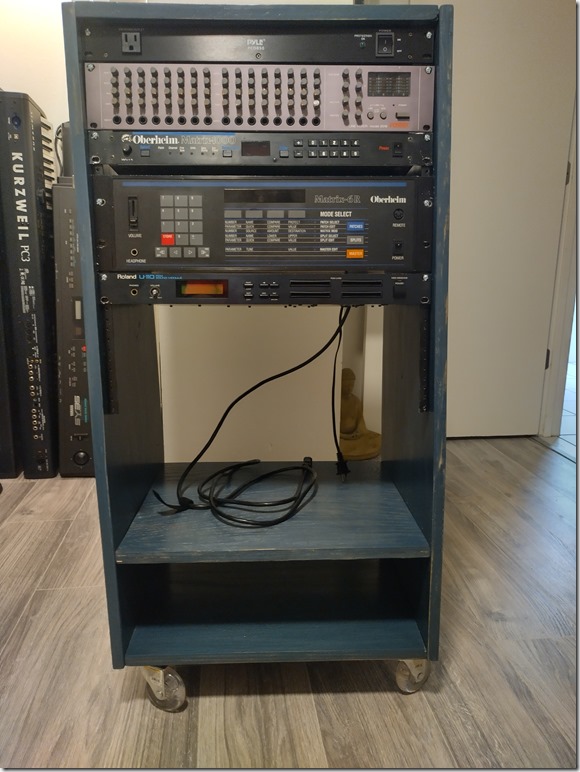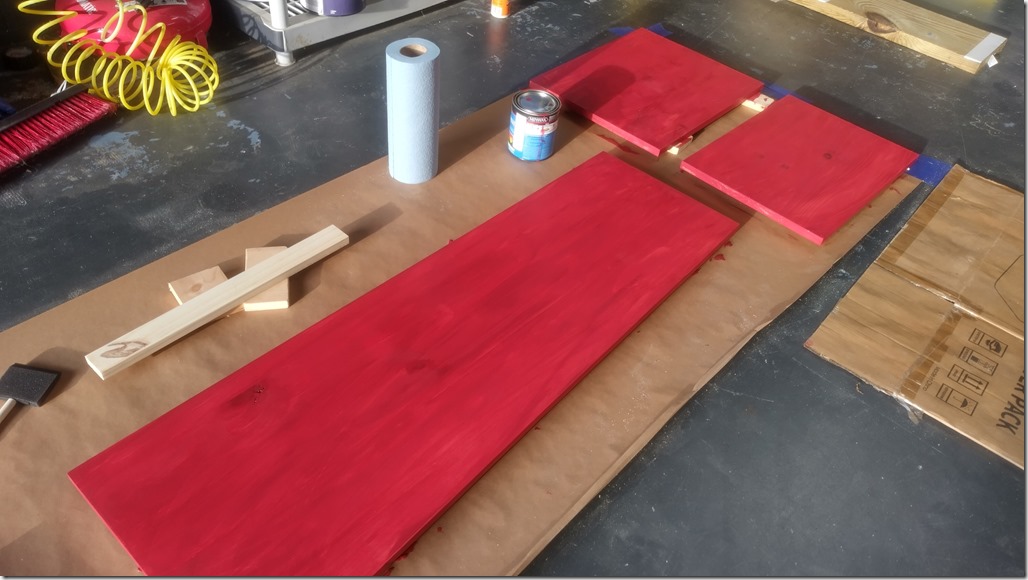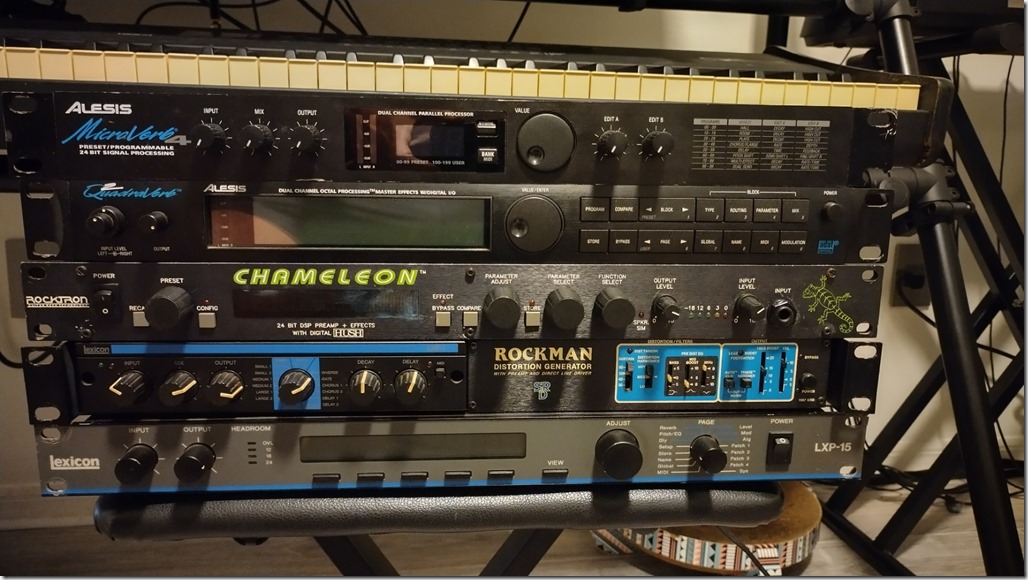Since this ongoing acquisition of music equipment shows little sign of slowing, I figured I would begin a record of my purchases, because I’m sure at some point, I’m going to want to look back at this period with a sense of awe and confusion.
For the longest time, I had somewhat the bare minimum of keyboards in my studio. The Roland RD-600 and the Casio CZ-1. The former because it was a workhorse and the latter because it was rare enough that I said I’d never get rid of it. And as I’ve said before, I do regret every piece of gear that I’ve ever gotten rid of, and now, I have every bit of it back and much more. So lets recap.
The impetus for this journey was a desire to re-record a lot of my old recordings in a higher quality. And to do so, I would need the original instruments. A lot of the newest music was done with software instruments, so that was a little tedious tracking down those bits of software. Unfortunately, I can’t find the exact version of some of them, so the sounds are slightly different in the redos.
Going back a little further in time, one of the devices I had was the Yamaha SW-1000 – a computer sound card. In studio form, this was the Yamaha MU-100. I didn’t fully know that at the time and mistakenly thought I needed its earlier version, the MU-80. So I bought an MU-80 in June, 2021 for $124 and began my work. I then found out that device did not have the exact sounds I needed and that I really needed an MU-100. 10 days later, I purchased an MU-100 for $199. There’s still a happy ending, because there were songs from even earlier from when I had the Yamaha SW-60 sound card in my computer, which was, in studio form… the MU-80.
Now, as I was reworking songs, there was a device that was needed and was a pain in the ass to find, the General Music Equinox. I did finally purchase one in December, 2022 for a whopping $1200. Its rarity sort of justified its cost and it will be a thorn in my side forever that I sold off my own 88-key version for so little.
And I think that’s when things really started to snowball. Because now I was working on songs from an even earlier era – the classic 90’s version of my studio. The only thing I had from that era was the MU-80, which replaced the SW-60 of its time. Problem was, gear from that era isn’t all that cheap. In January 2023, I located an Ensoniq ESQ-1 for $475. This was the bedrock of all the songs from that era. However, back then, I had all but one of the factory sound cartridges, and those cartridges remain impossible to find today. Research led me to a mega-cartridge containing all the ESQ-1 sound libraries. I bought one from a seller in Italy for around $130 in February.
Now it was time for another major purchase. I had an Oberheim Matrix 6R back in the day. I think I paid $650 at the time for a used one. But it’s one of the worshipped devices that has appreciated over time. They run $1200 or more, now. I found a Matrix 6R that “needed work” and bought it for $800 in February, 2023. After fixing it, playing with it, and discovering it didn’t have any of the same sounds I used to have, I purchased its cousin, the Matrix 1000, on a whim for $800 – again “needing work” – hoping it would have all the sounds I’d need. This purchase is still waiting for parts for repair. In the meantime, I’ve been using Sysex dumps on the Matrix 6 and making progress.
Drums in that era were handled by the cheapest drum machine available – the Yamaha RX21. I found one for $100 in March, 2023. The buyer took a week to ship it, then when I got it, it didn’t have a power supply and was packed terribly. The good news is, it did work well. The bad news is, it’s not the right model I needed. This machine does not have all the sounds I need. Additional research shows me I needed the RX17, not the RX21. Lower model number, but more sounds? Sounds about right for the era. So the RX21 is cleaned up and once I get a power supply (not going to fuck the customer like I got) it’ll be ready for resale. Hopefully I can break even on it. In the meantime, an RX17 is soon to be coming. As a postscript, all of this drum machine business was unneeded, because the Groove Agent VST in Cubase already has the samples for the RX17 as a patch called “Legacy”. Whatever. My studio is planned to be physical and not virtual anyway.
As I worked through the songs, it was comforting to see that the MIDI file could give me hints as to what device and patch was used for the track. I could count on MIDI channel 2 being the Roland Alpha Juno 1 and channel 3 being the Matrix 6, channel 16 being the drum machine, and 6-10 being the ESQ-1. But at some point, tracks with channel 4 started showing up. What was that device? The only other module I recall owning from that era what an Emu Proteus 1, but I don’t actually remember doing any recordings with it. However, my memory must be faded, because there’s some patches that I know don’t exist on either of the three other devices. So, a Proteus 1 is now being shipped. It cost $135 and it’s from a store I purchased something from back in the 90’s. Can’t remember what it was; it might have even been the ESQ-1.
So the studio has been rebuilt, but that is in no way the end of the purchases, because I’m not only trying to reconstruct old songs, but I want to do new stuff as well, and that means fresh gear for fresh sounds. So I’ve been opportunistic and buying whatever I think seems cool, and I gotta say, there’s lots of gear out there. At this point, I’m just going to use this post as a continually-updated log of the gear I find throughout the year.
One device that I picked up pre-pandemic (it’s a historical landmark now) is the Alesis QS-8. I bought it at a thrift shop and it never worked right, but I only paid $100 for it and it just sat in my closet for years. I did actually bring it back to life as detailed in another post, but its purchase was long before this buying frenzy.
In January 2023, I got a Korg DW-8000 on craigslist for $400 and a Roland D-70 from a pawn shop that needed significant work for $250.
In February 2023, I got a Roland Juno Di at a pawn shop for $80 that doesn’t work and needs professional repair. It’s sitting in my closet waiting for the shop to call when the parts come in. Another pawn shop had a Kawai K3 for $300.
In March 2023, EBay tempted me late at night with an auction that was getting no bids. That resulted in a Yamaha SY-35 for $175. One night browsing at the mall, I happened across an unwanted Roland U-110 in a resale store for $100. I also found a nice deal on a Kurzweil PC6 on craigslist for $300. That one was sold as having problems, which I confirmed. I poked around at the disassembled guts a few times and then somehow I changed the default startup patch and it started working and wouldn’t go dead anymore. So that was a fortunate fix.
In April 2023, I found an Alesis QS6 at a pawn shop, originally $300, down to $150. I got them to bring it to $120, because there was something loose rattling around inside. (It was a paint marker) Because it wasn’t the 6.1 version, the sounds were anemic, so I decided to flip it on EBay. It sold for $275 a month later. I also made a small purchase of an obsolete Edirol UM-3 MIDI interface to extend my MIDI connections to 6 in/6 out. I will still probably need a MIDI Thru box eventually. It was a whopping $23. I can support chaining one more UM-3, but the only other one for sale right now is over $60. Pass…
In May 2023, I made the purchase of the Roland U-220 to continue the work on legacy recording reconstruction. It was $130, which is a little under the going rate for that model. It has a dead battery and needed a small amount of repair. For something new, after I sold the Alesis, I poured that cash back into a new, rare, device, the Korg DSS-1. It was $279 at a thrift store a couple hundred miles away. I made the road trip and picked it up. I’m stealing someone’s comment on the device and its nickname is “the aircraft carrier” because it is a comically large size.
In June 2023, I found an obscure synth, the General Music SX3 on Craigslist for $250. I also made the decision to get rid of some items: the Matrix 6r and the U-110. The Matrix 1000 and U-220 are suitable replacements for them. When the Matrix 6 finally sold for $1k, I discovered I actually lost money on the deal. After I had paid the tax and shipping to get it to me, then paid for shipping and sellers fees ($130!) to get it from me, it was about $100 loss. Whatever. Moving on…
With the funds from the Matrix 6 sale, I purchased a Roland MKS-50, which is a rackmount Alpha Juno for $700. The VST Juno just was not stable enough to continue working with and it wasn’t as exact as the original. That fills in 1U of the 3U vacated by the Matrix. With the remainder of the funds, I finally made the leap and purchased the keyboard stand that will hold six of my boards, as well as a MIDI thru device to split the signal to all of them. The stand was about $350 and the MIDI thru box was about $75.
More online purchases to support the full integration of all the components: A vintage Casio TB-1 MIDI thru box for $65, a Behringer PX3000 patchbay for $90, and cables, MIDI and audio for a crushing $300. Also needed two more power strips – $50. And someone made me a $45 offer on a 3rd UM-3 unit, so I wasn’t going to disappoint them.
I’ve stopped totaling my spending and device count. It’s past the point of mattering.
Stay tuned for more madness…





